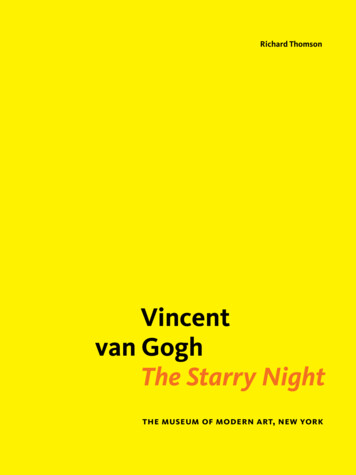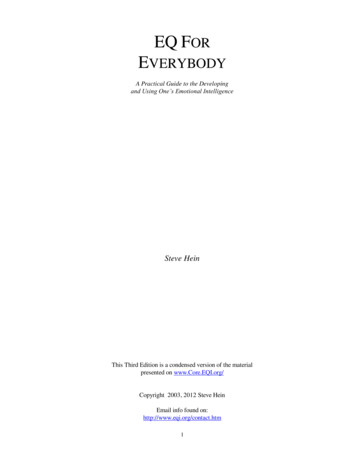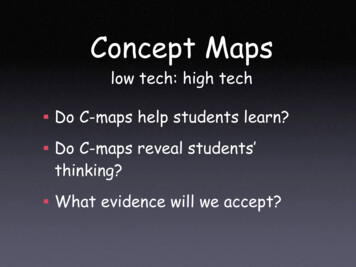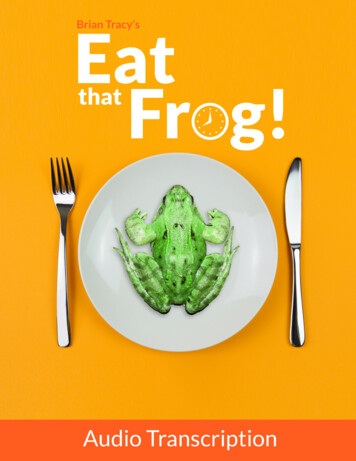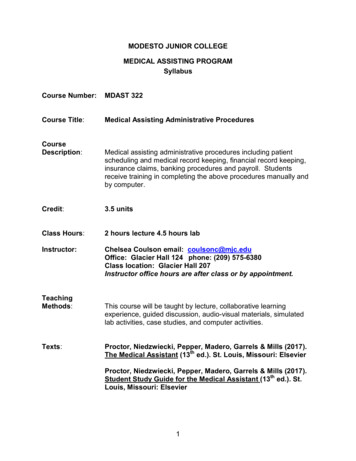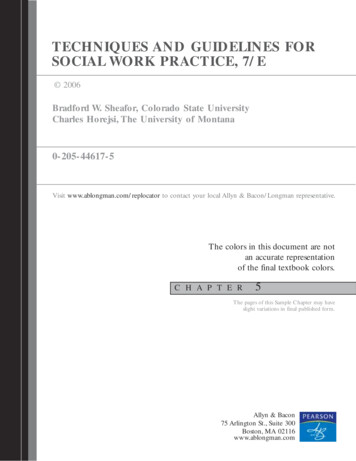
Transcription
Productive Information:Contextual Knowledgein Art Museum EducationBY OLGA M. HUBARDWhat is the place of contextual information in students’responses to artworks?Does it limit the possibility for a perceptual, personalrelationship with a work?Or can it enrich the encounter?Aiming for experiences that are both culturally responsible and personallymeaningful, in this article I offer guidelines to help museum educators andart teachers negotiate contextual information within group investigationsof works of art. To make my suggestions more tangible, I have illustratedmany of them with instances from my teaching practice.JULY 2007 / ART EDUCATION17
Contextual Information: Hindranceor Blessing?Group dialogue holds a prominent place in today’s artmuseum education. Through guided discussions,educators can engage students in meaningful investigations of artworks. Effective discussions have a back-andforth character: Viewers pay close attention to the worksin front of them, drawing from their lived experiencesto make sense of what they see.There is much that educators can do to encouragegroup inquiry. For example, they can pose thoughtful,open-ended questions that encourage people to lookmore closely at works of art. They can acknowledge allresponses, and weave them together into a larger web ofmeanings. They can invite students to ground theircomments in what they see, and ask them to probedeeper into their thoughts and feelings.1Museum educator Rika Burnham (1994) wrote thatthe purpose of group dialogue is not the “time-efficienttransfer of information” (1994, p. 523) about an object.The aim, rather, is to empower audiences to collectivelydiscover layers of meaning in works of art (Barrett,2000; Burnham & Kai-Kee, 2005; Greene, 2001; Rice,1995; Rice & Yenawine, 2002). Group discussions are,therefore, closely aligned with art criticism, as interpretation is the central activity (Barrett, 1994).2What, then, becomes of all the information thattraditional lectures used to deliver? Should educatorsattend to artists’ biographies, art historical categories,and critics’ interpretations? Or should they focusexclusively on the personal relationships that can beforged between a viewer and an object?Burnham (1994) explained that programs based onthe delivery of information can “severely limit thepossibility for a perceptual and personal relationshipwith a work of art . Students realize their participationis irrelevant, that other people have already defined whatis important and significant, [and they] tune out”(p. 521).3 Likewise, Philosopher John Armstrong (2000)said that a preoccupation with information “can be a wayof avoiding a more personal relationship with the object.External considerations can be so absorbing that theydraw our attention away from the very thing that theyare supposed to serve: We end up knowing about[emphasis added] the picture but not knowing it[emphasis added]” (p. 14).Nevertheless, Armstrong (2000) and Burnham andKai-Kee (2005) explained that contextual knowledgedoes not necessarily lead to impoverished engagement.Information can foster more detailed perception andopen up viewers’ appreciation. It can change, guide, anddevelop the way people see, deepening and enrichingtheir experience. In short, contextual knowledge is notin itself a hindrance or a blessing. It is what a spectatordoes with the information that matters. What arthistory student has not felt the satisfaction of walkingaround a museum, fitting objects into all the rightcategories? This one is Cubist, this one from Crete, thatone by Carracci. “Getting it right” can bring about afeeling of satisfaction and even impress others. Yet,merely attaching to a painting the label “Cubist,” keeps aviewer within the realm of impersonal generalizations.It is only when one explores with fresh eyes how Cubistprecepts play out in a particular picture that information about Cubism helps deepen understanding.4The Role of TeachersHow can teachers help students use informationproductively within dialogues about art? How can theyensure that facts will act as catalysts for significantmeaning making?These questions are frequent in the classes I teach tofuture art museum educators and school-based artteachers. I often cite Burnham (1994), and tell studentsthat the viewers’ experience comes first; that “information should be added only when it is not injurious to thefree flow of ideas and when it can validate understanding” (p. 524); that facts should be offered “gentlyand sensitively and at the right moment” (p. 524).But my students’ relentless curiosity (when is theright moment? how do I know if I’m being sensitive?)has pushed me to look closer at my teaching practice.I’ve realized that I have collected a series of tips thatguide my decisions regarding the delivery of information, and that sharing these guidelines with my studentscan be helpful. You will find them in the next section.These tips are not to be regarded as set rules but asfluid guidelines. Depending on a particular situation:on the artwork, the audience, and the gist of theconversation, a given tip may be more or less applicable.In other words, this article is not intended as anauthoritative manual. Rather, it is meant to inspirereflection about how teachers can allow information toilluminate art viewers about other ways of being, whilealso enabling them to gain insights into themselves.What, then, becomes of all the information that traditional lectures used to deliver?Should educators attend to artists’ biographies, art historical categories, and critics’interpretations? Or should they focus exclusively on the personal relationshipsthat can be forged between a viewer and an object?18ART EDUCATION / JULY 2007
Tips for Productive ViewingBefore You Start. Become comfortable teaching bydiscussion, and be clear about why you want to use thisapproach. These guidelines will only work if you canhelp students look, respond, and share, and if youembrace a genuine spirit of investigation.What to Say (or Not to Say). (1) Be as informed asyou can about a work (Burnham & Kai-Kee, 2005), andbe prepared to call on whatever information you mayneed. Think of the information you hold as a wellstocked pantry. Though you may have innumerableingredients, you use only those that make a specific dishtastier. (2) Consider how important a particular piece ofknowledge is to the understanding of a work. Forexample, to understand Pablo Picasso’s Guernica (1937,Museo Reina Sofia, Madrid) it is more relevant to knowthat the town of Guernica was bombarded during theSpanish Civil War than to learn that Picasso had manywives.5 (3) If you are using a theme to thread together aseries of works, identify information that is relevant tothis theme. For instance, if your theme is “Identity,”telling viewers that a painting by Rembrandt van Rijn isa self-portrait (Self-Portrait, 1660, Metropolitan Museumof Art) will be particularly helpful. (4) When sharingbiographical information, be mindful of the impulse topsychoanalyze the artist. Psychoanalytic examinationHow can teachers help students use informationproductively within dialogues about art? Howcan they ensure that facts will act as catalystsfor significant meaning making?demands a rigorously trained interpreter and thoroughresearch. Attempts to psychoanalyze within a museumeducation program often leads to limiting explications,such as “Jackson Pollock dripped paint because he was anenraged drunk”. (5) Be mindful of “gossipy” information:Vincent Van Gogh cut his ear off; Artemisia Gentileschiwas raped; Thomas Eakins slept with his students. Suchinformation can easily take viewers away from the art.This said, some artworks deal specifically with contentfrom the artists’ life. For instance, Frida Kahlo’s SelfPortrait with Cropped Hair (1940, Museum of ModernArt) relates to her troubled relationship with her husband,artist Diego Rivera. If seemingly gossipy information isrelevant to an artwork, integrate it responsibly. Butremember: Artists’ lives are one of several windows intotheir work. (6) Consider the relevance of the informationto different audiences. What an adult finds helpful mightnot be so useful to an 8-year-old.6JULY 2007 / ART EDUCATION19
If you share a preexisting interpretation of a work, explain that this is notits “ultimate meaning,” but someone’s vision. Ask the group to respond.Does the interpretation support or change their experience of the work?Does it limit their investigation or open new perspectives?Looking for Information. (1) Many texts includedescriptions of artworks. Rather than sharing descriptions, invite people to look: they will arrive at descriptions on their own. For example, viewers can easilynotice that Piet Mondrian used only blue, red, yellow,black, white and straight lines in Broadway BoogieWoogie (1942-43, Museum of Modern Art). (2) Manyart historical categories and interpretations originatedthrough someone’s observation process (Armstrong,2000). One example is the categories that HeinrichWölfflin (1915/1998) developed to distinguish Classicand Baroque painting (linear/painterly, plan/recession,closed form/open form, multiplicity/unity, and absoluteclarity/relative clarity). If you would like to shareinformation of this sort, consider whether viewersmight be able to arrive at it by looking. For instance,you might invite people to compare Raphael’s Madonnadi Foligno (1512, Vatican Museum) to Peter PaulRubens’ Assumption of the Virgin (mid 1620s, NationalGallery of Art, Washington). Viewers are likely to noticethat a clear edge defines the figures in the Raphael(linear), whereas the forms appear to merge with oneanother in the Rubens (painterly). By the same token,beware of making the identification of preexisting ideasa goal: Throughout their investigation, spectators mightdiscover new and insightful categories that add to,challenge, or complicate existing ones. (3) Viewers’questions can sometimes be answered, even if partially,through observation. For instance, close scrutiny of acarved, wooden sculpture might help answer thequestion, how was this artwork made? (If a questioncan’t be answered by looking, provide the answer. Afeeling that the teacher is withholding information cantake away from an invaluable climate of trust. If you donot know the answer to a question, be honest. If youhave a good reason to hold the answer to a question forlater in a conversation, say so.)Using Knowledge: The Importance of Timing.(1) If you offer information too early, it can shut outviewers’ ideas. If you give it all at the end, it can have a“here’s the real story” tone, which either invalidatesparticipants’ insights or lets them know they “got itright.” Either way, you (and the information you hold)become the authority, taking away from the spirit ofcollective meaning making. More important, if viewersreceive all the information at the end, they will not usethe new knowledge to deepen and enrich theirinvestigation. Thus, weaving information at key20ART EDUCATION / JULY 2007moments throughout the conversation is mostproductive (Schmidt, 2004). (2) If the dialogue comesclose to a particular piece of information, you knowyour audience is getting ready for what you have to say.Share the information when that line of investigationcannot go further without the new knowledge. At thatpoint, the information will support viewers’ responseswithout cutting important discoveries short. Forexample, a group looking at Mondrian’s BroadwayBoogie Woogie (1942-43, Museum of Modern Art)might note that the painting is reminiscent of an aerialcity view, and that the small, colorful squares look likemoving cars. This would be a good moment to offer thework’s title, and to explain that Mondrian was inspiredby the energy and music of 1940s Manhattan. After youintroduce a piece of information, let the group use it todeepen their investigation (Armstrong, 2000; Burnham& Kai-Kee, 2005; Schmidt, 2004). Having shared thetitle of Broadway Boogie Woogie, discuss: How is thepicture reminiscent of a busy city street? How is itdifferent? (3) It is common for audiences to debate anambiguous element in a work. For example, viewerslooking at Winter Play (circa 1130s-60s) by So Hanch’en, discuss the gender of the two children portrayed.Some believe they are two boys; others argue that one isa boy and the other a girl. Through research, you knowthat one of the figures indeed represents a girl. Let thedebate unfold before you share this information;important insights might surface along the way. Afteryou share your knowledge, invite the group to continuethe investigation, integrating the new learning.Facts and Interpretations. (1) Distinguish factualinformation from interpretive information. Facts arewhat people know to be true: This sculpture is made outof marble; Frank Gehry designed this building. Bycontrast, interpretations express the meaning orrelevance that individuals find in a work: This workembodies hope in the face of destruction; that onecelebrates the everyday. Interpretations are born whenpeople make connections between what they see andwhat they know about art and life. If you share apreexisting interpretation of a work, explain that this isnot its “ultimate meaning,” but someone’s vision. Askthe group to respond. Does the interpretation supportor change their experience of the work? Does it limittheir investigation or open new perspectives? Bear inmind that multiple interpretations, even contradictoryones, work together to illuminate a work (Barrett, 2000;
Burnham & Kai-Kee, 2005; Eco, 1989; Gadamer, 2000;Hooper-Greenhill, 1994). This, however, is not the casewith factual information. Whereas it is acceptable to say,“To some of us, this work embodies hope in the face ofdestruction; to others it celebrates the everyday,” itwould be ludicrous to say, “To some this sculpture ismade out of marble; for others it is made out of wood.”Celebrate multiple interpretations of an object, andcommunica
2000; Burnham & Kai-Kee, 2005; Greene, 2001; Rice, 1995; Rice & Yenawine, 2002). Group discussions are, therefore, closely aligned with art criticism, as
